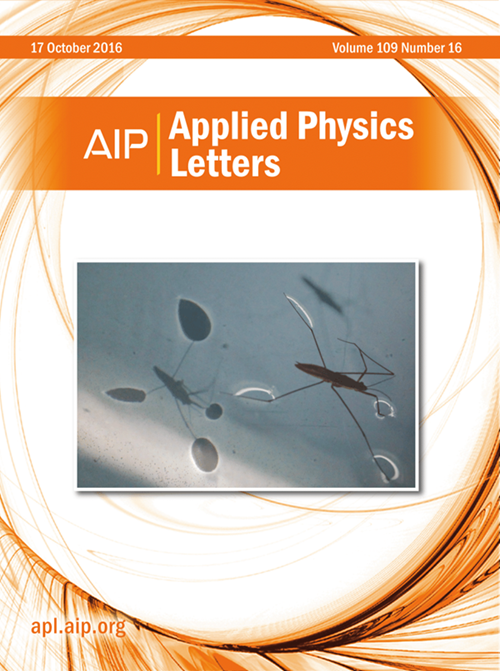Synthetic control of monolayer, bilayer, and trilayer WSe2 single crystals for high-performance 2D p-type transistors
IF 3.5
2区 物理与天体物理
Q2 PHYSICS, APPLIED
引用次数: 0
Abstract
The two-dimensional (2D) complementary metal–oxide–semiconductor circuits require balanced performance between p-type and n-type devices, but currently, among two-dimensional semiconductor materials, the electrical performance of p-type WSe2 is significantly inferior to that of n-type MoS2. This performance bottleneck is primarily attributed to issues with the growth quality of WSe2, interfacial defects, and the influence of charged impurities, which collectively limit the application of WSe2 in low-power integrated circuits. To address this challenge, we report that the monolayer (1L), bilayer (2L), and trilayer (3L) WSe2 single crystals can be selectively grown on high-κ SiNx/Si substrate by precisely adjusting the carrier gas direction over time in a reverse-flow chemical vapor deposition system. Using this growth method, Raman/photoluminescence spectroscopy, scanning transmission electron microscopy, and selected-area electron diffraction confirm that the as-grown 1–3L WSe2 nanosheets are single-crystalline with excellent quality. By employing Pt metallization process to construct optimized metal–semiconductor contacts, the fabricated mono-to bilayer WSe2 transistors exhibit pronounced p-type characteristics with superior performance. In particular, the 1L WSe2 transistors with a channel length of 2 μm display a record-breaking on-state current of ∼500 μA/μm at room temperature. This controllable synthesis strategy demonstrates potential for advancing WSe2-based p-type electronics in microelectronic applications.用于高性能二维p型晶体管的单层、双层和三层WSe2单晶的合成控制
二维(2D)互补金属氧化物半导体电路要求p型和n型器件之间的性能平衡,但目前在二维半导体材料中,p型WSe2的电学性能明显不如n型MoS2。这种性能瓶颈主要是由于WSe2的生长质量问题、界面缺陷和带电杂质的影响,这些问题共同限制了WSe2在低功耗集成电路中的应用。为了解决这一挑战,我们报告了在逆流化学气相沉积系统中,通过精确调节载气方向,可以在高κ SiNx/Si衬底上选择性地生长单层(1L),双层(2L)和三层(3L) WSe2单晶。利用这种生长方法,拉曼/光致发光光谱、扫描透射电镜和选择区域电子衍射证实了生长的1-3L WSe2纳米片是单晶的,具有优良的质量。采用Pt金属化工艺构建优化的金属-半导体触点,制备的单-双层WSe2晶体管具有明显的p型特性,性能优越。特别是,通道长度为2 μm的1L WSe2晶体管在室温下的导通电流达到了创纪录的500 μA/μm。这种可控合成策略显示了在微电子应用中推进基于wse2的p型电子器件的潜力。
本文章由计算机程序翻译,如有差异,请以英文原文为准。
求助全文
约1分钟内获得全文
求助全文
来源期刊

Applied Physics Letters
物理-物理:应用
CiteScore
6.40
自引率
10.00%
发文量
1821
审稿时长
1.6 months
期刊介绍:
Applied Physics Letters (APL) features concise, up-to-date reports on significant new findings in applied physics. Emphasizing rapid dissemination of key data and new physical insights, APL offers prompt publication of new experimental and theoretical papers reporting applications of physics phenomena to all branches of science, engineering, and modern technology.
In addition to regular articles, the journal also publishes invited Fast Track, Perspectives, and in-depth Editorials which report on cutting-edge areas in applied physics.
APL Perspectives are forward-looking invited letters which highlight recent developments or discoveries. Emphasis is placed on very recent developments, potentially disruptive technologies, open questions and possible solutions. They also include a mini-roadmap detailing where the community should direct efforts in order for the phenomena to be viable for application and the challenges associated with meeting that performance threshold. Perspectives are characterized by personal viewpoints and opinions of recognized experts in the field.
Fast Track articles are invited original research articles that report results that are particularly novel and important or provide a significant advancement in an emerging field. Because of the urgency and scientific importance of the work, the peer review process is accelerated. If, during the review process, it becomes apparent that the paper does not meet the Fast Track criterion, it is returned to a normal track.
 求助内容:
求助内容: 应助结果提醒方式:
应助结果提醒方式:


